We may earn income from links in this post. Please read this Disclosure for details.
If you’re planning a trip to Guatemala, you don’t want to miss la Quema del Diablo – the Burning of the Devil. Not only is el Día del Diablo (the Day of the Devil) one of the most important Christmas holiday traditions in Guatemala, it’s one of the world’s most exciting fire festivals.
Every year on December 7th, Guatemalans light bonfires and burn the devil in effigy.
While many celebrations take place on streets outside people’s homes, the most spectacular event is the Quema del Diablo or Burning of the Devil in the country’s former capital city of La Antigua.
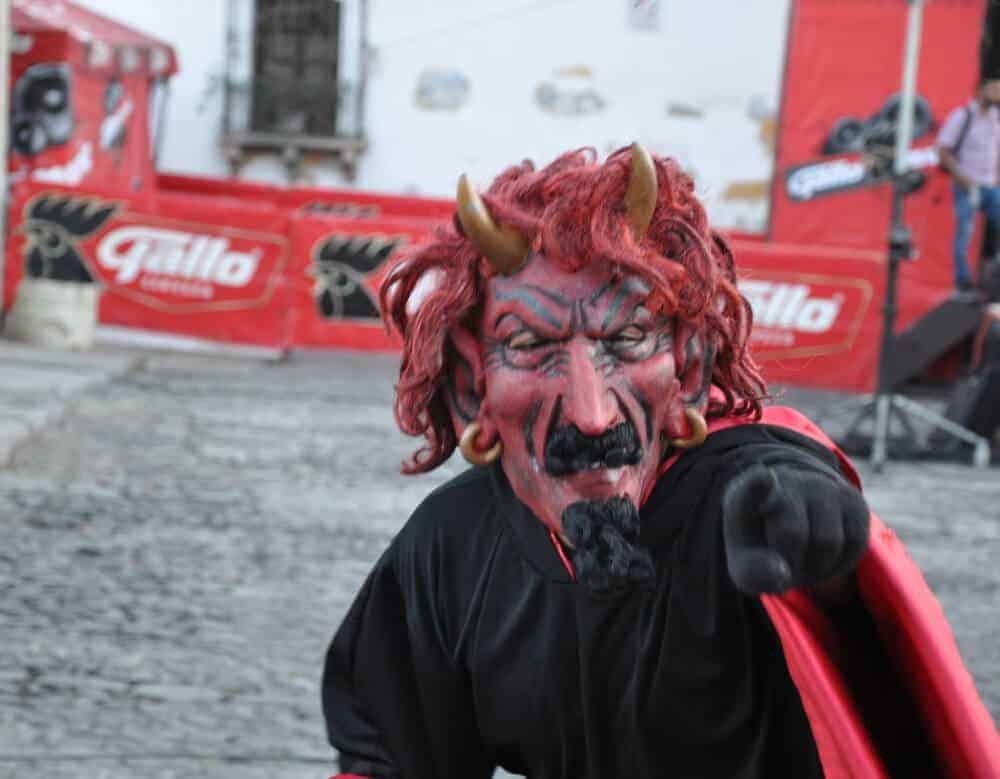
How Do they Celebrate Christmas in Guatemala on Dia del Diablo?
During this special Guatemalan tradition, people douse enormous effigies with gasoline and light them on fire in the streets in a ceremony called la quema del diablo (burning of the devil).
They also light bonfires, buy devil piñatas and enjoy special día del diablo food. The fiery festivities kick off the beginning of the Christmas season in Guatemala.
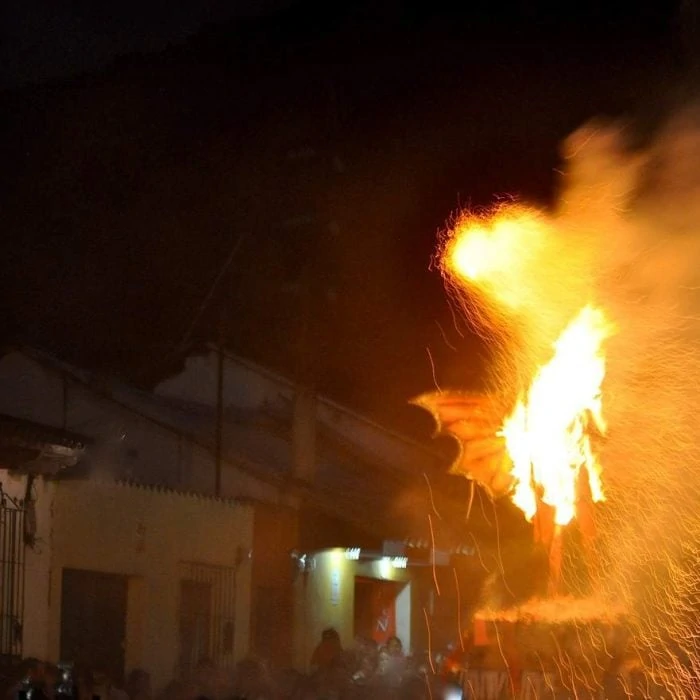
It’s well worth travelling to Guatemala to experience the Burning of the Devil festival in person!
While it’s possible to experience the Quema del Diablo independently (and instructions to do so are below), the best way to get the most out of it is on a private walking tour of Antigua.
Check prices and availability of a private walking tour of Antigua on Viator.com.
History of La Quema del Diablo (Burning of the Devil) in Guatemala
Like many other major celebrations and traditions in Guatemala, the Burning of the Devil is a Guatemalan custom deeply rooted in spiritual and pre-Hispanic beliefs.
Its history dates back to ancient times.
The power of fire has long been recognized by early cultures who revered the element of fire for its ability to provide warmth, to provide sustenance through cooking as well as its ability to destroy.
Fire rituals can be seen in virtually every culture and religion around the world.
From Buddhist Fire ceremonies to First Nations smoke smudging traditions to the fireworks of Valencia, the primary symbolic function of fire is one of purification, cleansing and transformation into the divine.
In Guatemala, the tradition of la quema del diablo or burning of the devil symbolizes the ritual cleansing and banishment of bad spirits to usher in the Christmas season.
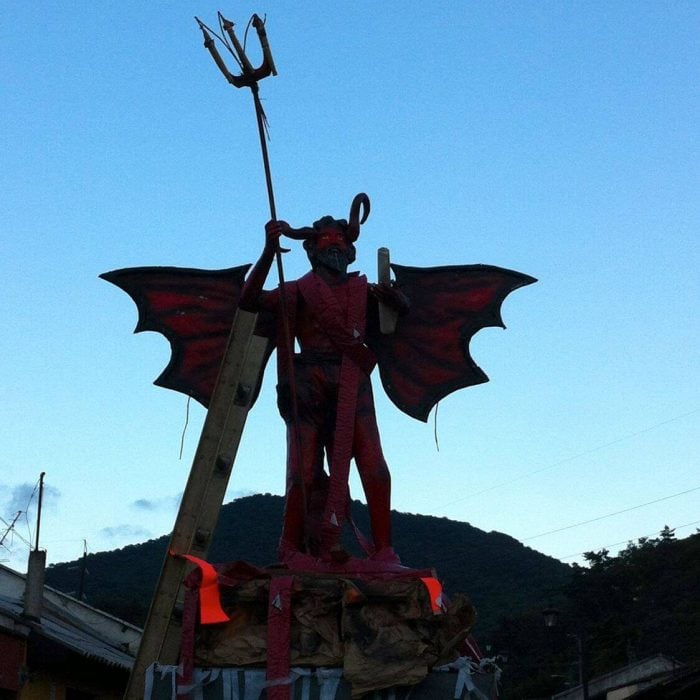
It’s a process of purification leading up to a holy season filled with important religious dates and other Guatemala Christmas traditions.
These include:
- December 8th Feast Day honouring the Conception of the Virgin Mary.
- nightly posadas (processions) that take place during the nine days leading to Christmas.
- Christmas Eve or Nochebuena.
- Navidad (Christmas Day)
- Three Kings Day.
When is Día del Diablo in Guatemala?
While the Día del Diablo and the fire ceremonies, fireworks and festivities take place on December 7th, preparations begin several days in advance.
One of the places to go to fully understand this Guatemalan tradition is the village of Concepción. This picturesque Maya village is set in a fertile valley 20 minutes from Sololá, near Lake Atitlan, a major natural landmark in Guatemala.
The town’s patron saint is dedicated to the Virgin Mary and her saint day of December 8th. At the heart of Concepción is a sturdy Catholic church constructed in 1621.
It’s one of Guatemala’s few wooden churches to have survived centuries of earthquakes. It features a wooden roof carved with angels, saints and apostles.
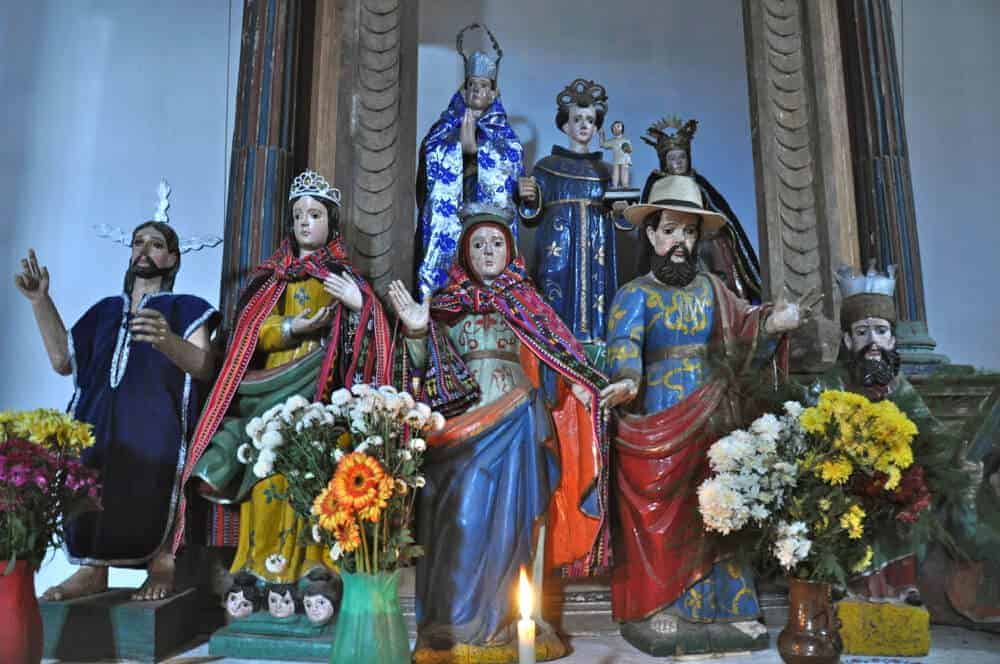
It’s also home to an active cofradía, a Maya brotherhood who are guardians of ancient religious practices.
Many still wear their traditional embroidered clothing featuring a distinctive bat–a symbol for the last Kaqchikel dynasty–atop rainbow-hued trousers, a tunic wrap and sandals.
For the December 8th Feast Day honouring the Conception of the Virgin Mary, they lay wooden platforms through the center aisle of the church to serve as pagan altars for offerings of food, candles and other tribute.
The church brotherhood also installs a ceremonial silver candelabra and carries the Virgin in procession through the village.
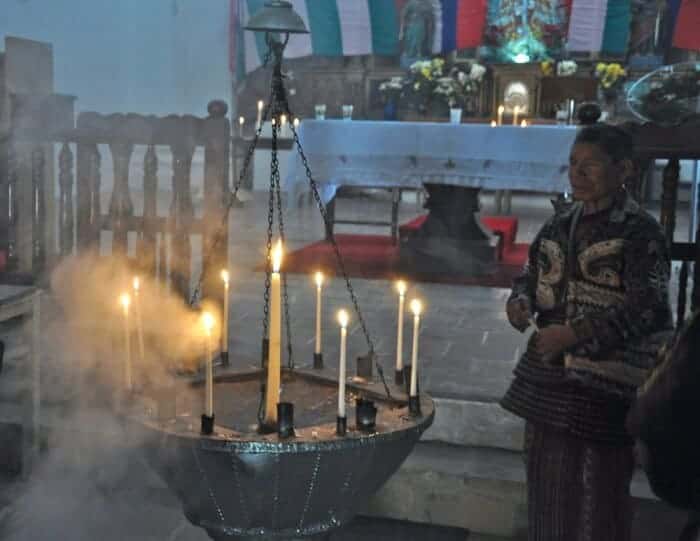
It’s incredible to see the diminutive stature of the Virgin festooned with money, lottery tickets and other adornment for her saint day.
The locals also celebrate with fireworks, music and special dishes such as pulique, a chicken stew.
Tip: Learn how to prepare authentic Maya pulique in my post on Cooking Class in Guatemala: Pulique.
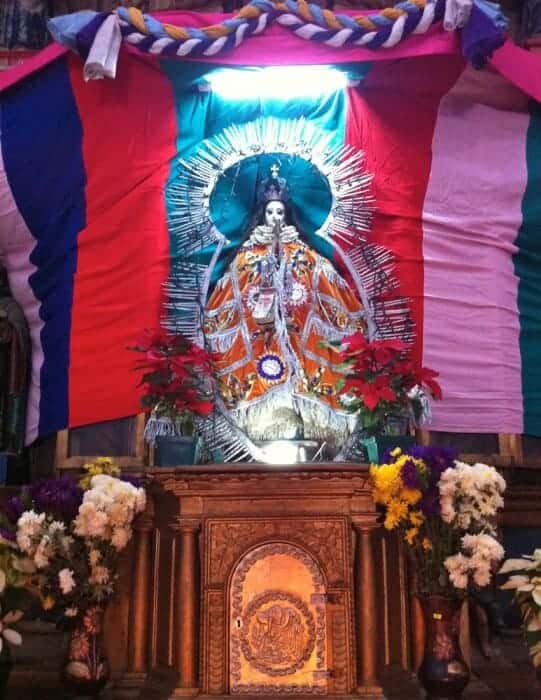
Where is the Burning of the Devil in Antigua Guatemala
In addition to being the heart of organized festivities for la Quema del Diablo in Guatemala, Antigua is also a great base for experiencing Semana Santa (Easter Holy Week) and Day of the Dead, other unique Guatemala celebrations.
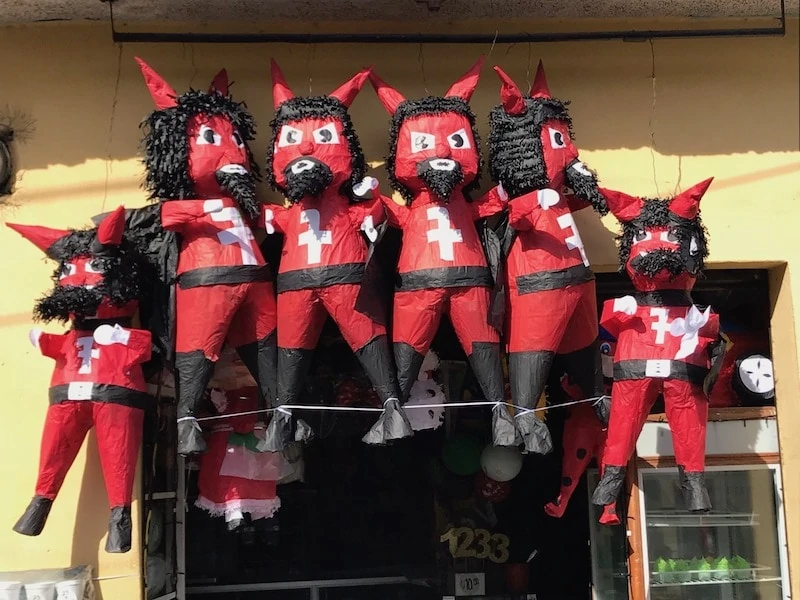
Some of the other top things to do in Antigua include studying Spanish at one of the many Spanish language schools, climbing a volcano and visiting the coffee plantation dotted on the lush volcanic slopes nearby.
A good hotel for Day of the Devil is Hotel Mestizo Antigua, an art-filled boutique hotel in the heart of Antigua.
One of 3 Budget Hotels to Love in Antigua), it offer a sense of tranquility with spectacular views of Agua Volcano from the rooftop.
Check rates and availability of Hotel Mestizo Antigua on Booking.com
As the sun begins to set in the evening of Dec. 7th, people make their way to Barrio de Concepcion.
In Antigua this is the epicentre of Quema del Diablo or Burning of the Devil festivities.
You know you’re in the right neighbourhood when you see this sign. Or, just follow the crowds.
It’s the opposite side of town from La Merced church.
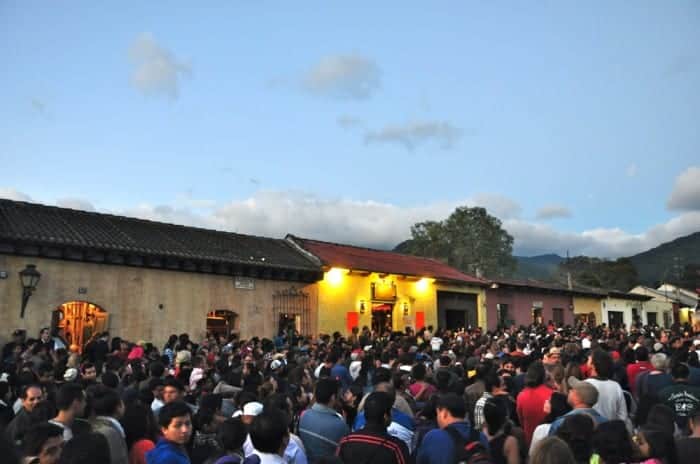
Although other Guatemalan communities celebrate by burning tires in the streets, in the Concepcion neighborhood of Antigua, authorities are trying to keep festivities under control for safety reasons.
A papier-mâché effigy of the devil serves as a hub for a giant communal bonfire. A firetruck with firefighters is always nearby on standby.
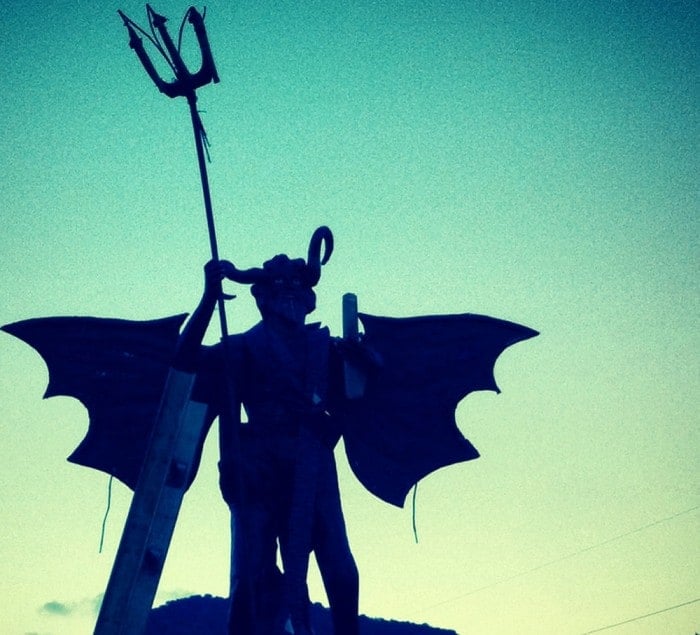
Food, Drink and Festivities
Much like most other Guatemala celebrations, food and drink are highlights of this festival. Traditional street food stands are packed with street food goodies including:
- bunuelos, deep friend donuts drenched in anise-scented honey.
- rompope, a spiced eggnog from Quetzaltenango.
- tortas (crusty buns stuffed with meat and crisp vegetables).
- garnachas (crispy tortillas topped with shredded meat and curtido).
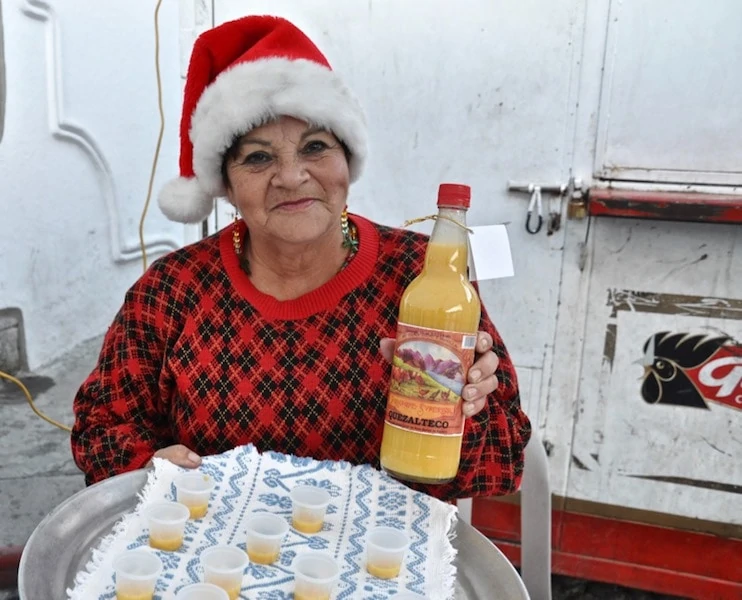
Rubbing shoulders with locals, you can watch as the 10-foot tall devils, such as the one pictured above (crafted by artist Pablo Godinez Pichiya), get soaked with an incendiary fuel.
Then, a costumed announcer will step forward. And, to the sound of a full brass band, he’ll renounce a long list of transgressions committed by politicians.
Then, a flaming torch sets the effigy of the devil on fire.
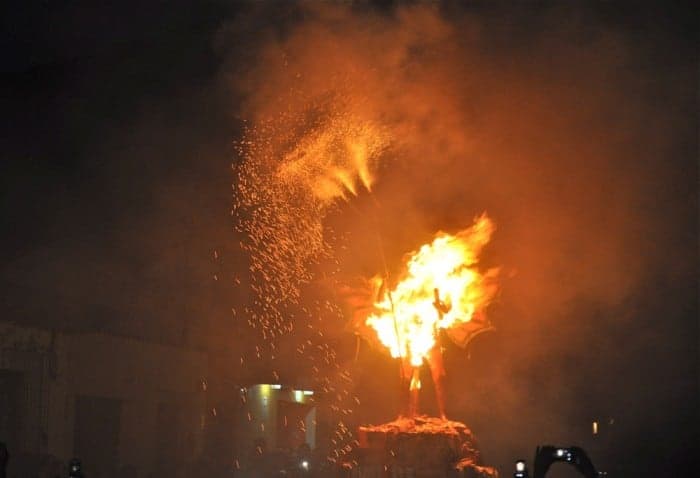
While the devil burns, flames and sparks will dance into the night sky.
Between cameras flashing and shouts from the crowd it’s a bacchanalian celebration merging Guy Fawkes Day and Halloween.
The Burning of the Devil – La Quema del Diablo – is an incredible (and unique) way to usher in the Christmas season!
Travel Planner for Burning of the Devil in Guatemala
When: December 7th at 6 pm
Where to go for Día del Diablo: Calle de la Concepcion in La Antigua, Guatemala
Tours of Guatemala: Culture Xplorers partners with local communities to offer a range of cultural tours as well as custom tours through Guatemala. My guide was Adolfo Cruz, a cultural expert and interpreter from Culture Xplorers.
Tour of Antigua: Take a cultural and historical walking tour of Antigua. Explore this UNESCO World Heritage Site, visiting highlights like the Ayuntamiento, Palace of the Captain’s General, the main cathedral, and Santo Domingo.
Getting Around: I recommend taking private transportation from Guatemala Airport to Antigua. The trip should take no more than 1.5 hours.
While it’s cheaper to take a shared group shuttle, it can be cramped. Plus it really adds to the transfer time. Unless you’re lucky to be dropped off first, you’ll spend a lot of time bouncing along the cobbled streets of Antigua dropping off other passengers.
If you’re coming from Mexico, read more about transportation to Guatemala in Night Bus to Guatemala.
Safety: It’s a wise idea to stay far away from the burning devil itself as sparks and glowing embers can travel if there’s any wind.
Follow our Safety Tips for Travel in Guatemala and if you need assistance, contact INGUAT, the Guatemalan Tourist Assistance office.



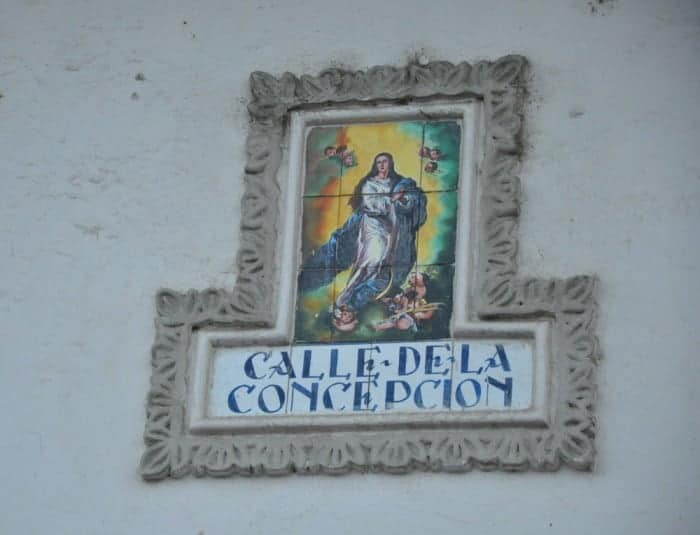




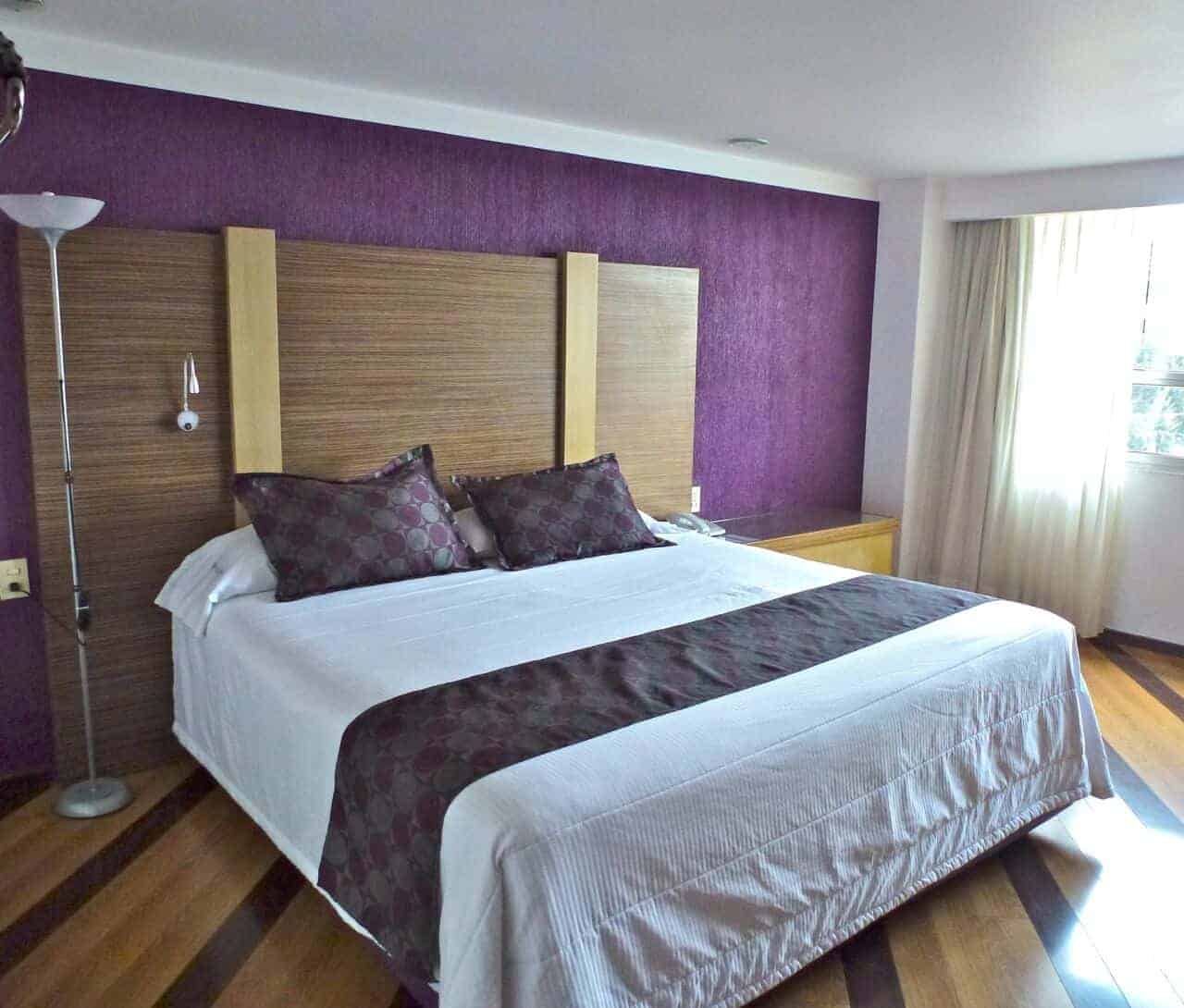 Grand Prix: A Cheap Hotel near Mexico City Airport
Grand Prix: A Cheap Hotel near Mexico City Airport
Tasha
Could you tell me about the house cleaning, yard and garden cleaning for Quema Del please?
Michele Peterson
Hi Tasha Many cultures from China to have traditions and superstitions that involve cleaning the house or washing clothing to usher in a new season or New Year. The concept behind “Out with the old and in with the new” is warding off bad luck and welcoming good energy. In Guatemala some people will sweep their homes from the inside out and gather piles of rubbish that will be burned on the street in front of their homes. The little pinatas of the devil and fireworks are often thrown on the fire to add to the flames.
Colleen Friesen
Ha! You’re so right. I’d prefer this ceremony to shopping in a mall any day. What a great post. Thanks Michele!
Jaynie
Thank you for this post. I was in Bocas del Toro, Panama one time and I saw people wearing these masks! It was nighttime in Feb and the power was out so it makes no sense. At least now I know what they traditionally used them for. 🙂
Michele Peterson
I’ve long wanted to go to Bocas del Toro so it’s really interesting that they also wear Dia del Diablo masks there.